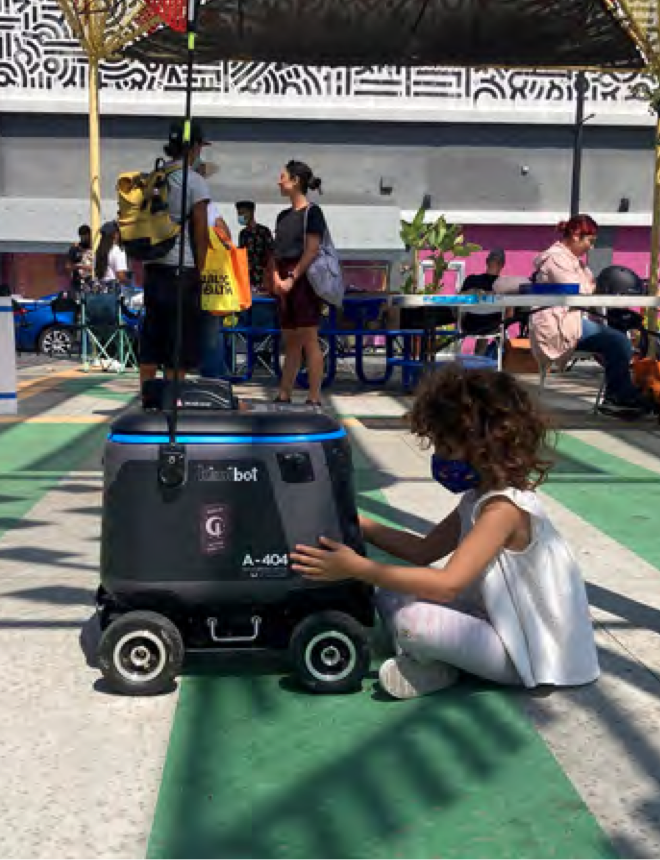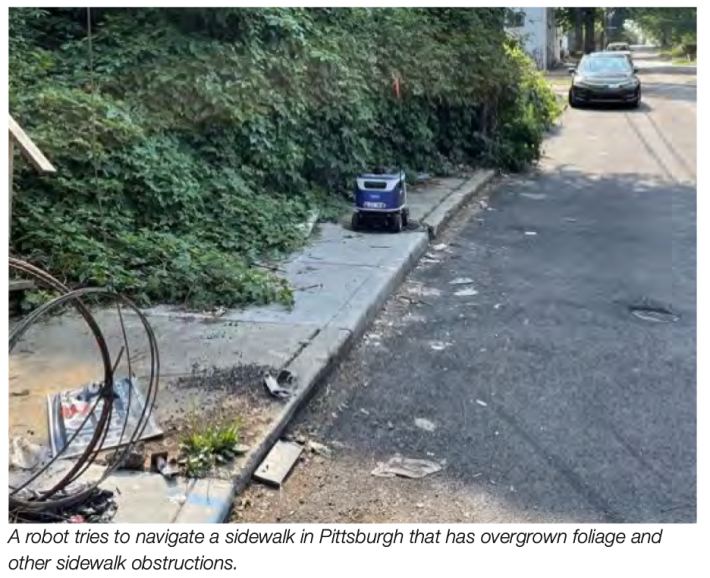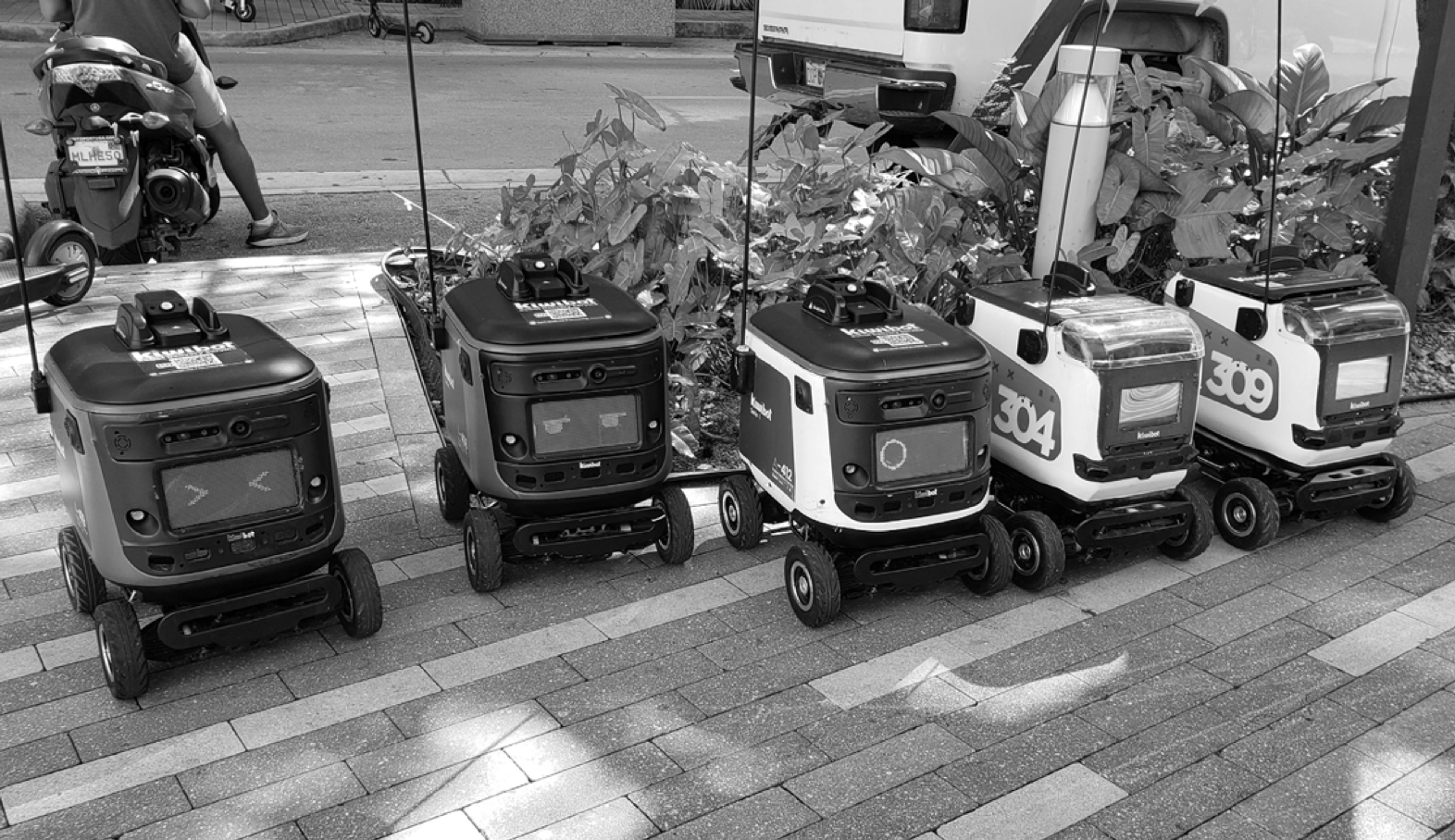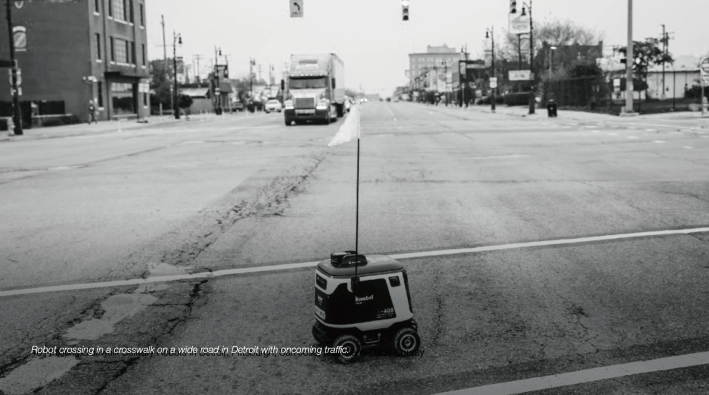Whether contending with broken pavement or speeding drivers, sidewalk delivery robots struggle to get around U.S. cities for many of the same reasons as human pedestrians, a new study finds — but that's not the only reason why the emerging technology might struggle to deliver on its car-cutting promises without careful planning.
Researchers at the University of Oregon's Urbanism Next Center and the consultancy group CityFi partnered with the Knight Foundation to bring a small fleet of "pedestrian delivery devices," or PDDs, to the sidewalks of four U.S. cities and explore whether they could be used to meet local goals — without subtracting even more of the scarce right-of-way that cities grant to humans who walk and roll.

The communities in the pilot — Detroit, Pittsburgh, San José and Miami-Dade County — all had a long history of welcoming the autonomous vehicle industry onto their roads, but less experience with the kind of robo-vehicles specifically designed to share the footpath with people.
That's in part because sidewalk delivery robots are still relatively rare in the U.S., and the few that are out there are the subject of hot debate. Proponents of PDDs say that many short delivery trips currently performed by dangerous, polluting trucks could theoretically be done by slow, suitcase-sized 'bots instead, even as cities like Toronto have balked at the idea of undermining their residents' already-threatened access to car-free road space.
The researchers behind the study, though, emphasize that the pilot was explicitly not designed to sell anyone on the controversial technology, but to see if PDDs could benefit some neighborhoods — and if so, how to roll them out right.
"The Knight Foundation's goal was definitely not to see these things deployed on our streets," said Nico Larco, director of the Urbanism Next Center and co-author of the report. "The question was, 'If PDDs are deployed, how do we do so in a way that helps achieve community goals? ... How can we make sure that we have equitable deployment of these vehicles, while, at the same time, not simply proliferating the problems that already exist in our transportation system?'"
To answer those questions, delivery startup Kiwibot — known mostly for making deliveries on college campuses using AVs capped at four miles per hour — deployed a small fleet of semi-autonomous PDDs to perform thousands of both simulated and actual robo-deliveries of food and consumer goods within the devices' 1.5-mile delivery radius. Over the six-month pilot, researchers engaged thousands of passersby, business owners, and other stakeholders about what they thought of the bots — and studied how well the bots did at navigating a car-dominated landscape.
Pretty quickly, the pedestrian delivery devices encountered many of the same challenges to getting around safely as their human counterparts — particularly those who rely on wheelchairs and other assistive devices to get around.
In Pittsburgh, the Kiwibots found themselves unable to operate in a key neighborhood "due to infrastructure limitations such as cracked sidewalks ... sidewalk obstructions such as overgrown trees or bushes, or if cars were parked blocking the [way]." Detroit's PDDs, meanwhile, struggled to cross a particularly wide road on their route with a too-short walk signal and an inaccessible median, and some of San Jose's bots got stuck or tipped over when confronted with sidewalk obstructions, rendering themselves inoperable.
On several occasions, the Kiwibots were even hit by drivers — an experience that, unfortunately, they share with far too many flesh-and-blood delivery people.
"For these robots to work, the city has to be walkable," said Larco. "A lot of these cities have sidewalks that are too narrow, or there's no ADA ramp on one side —or even both sides — of the street. That doesn't work for people, either.
In some cases, the Kiwibots were able to map where walking conditions were wanting and share that data with the researchers — though Larco points out that whether cities will actually have the money to fix problems that bots might spot is a separate question. And in some cases, humans actually had to help the robots get around, such as righting them when they tripped on a piece of broken pavement.
Interestingly, none of the pilot participants reported any significant conflicts between pedestrians and PDDs, though Larco speculates that may be because there were fewer than 10 bots in each city, and some of their common routes have very few people walking around. In an urban metropolis where sidewalk space is a scarce and precious resource, Larco acknowledges that the conversation might be very different.
"In the pilots, there weren’t any incidents of real challenges between pedestrians and robots; there was more curiosity than anything," he added. "But you can imagine that if pilot this was to tremendously scale up, or to be deployed in a denser urban areas, we might have different challenges...We'd have to find out; how much engagement would there be with the robots? Would people have an aversion to them? Would they trust them? Would they decide to play with them? Or would they derail them? "

Larco adds, though, that dangerous or crowded built environments aren't the only barriers that delivery bots might face on the road to widespread adoption. The researchers initially hoped to use the bots to help small businesses establish a low-cost delivery service — a particularly urgent concern during the first year of the pandemic, when the pilot took place — but found that some struggled to integrate the technology into their workflow because they didn't even have websites, much less an ordering platform that could integrate seamlessly with cutting-edge tech.
All those struggles, Larco warns, could have real consequences for city residents who might come to rely on PDDs. Though delivery bots have been put forward as a great way to, for instance, bring a can of baby formula to the doorstep of an exhausted new parent in the middle of the night, the stakes of that package not showing up may be too high to entrust to a robot that could be sidelined by a software glitch or a car parked on the sidewalk. The researchers warn that PDDS are "not ready to fulfill essential community needs," and that even small pilots should focus on less-critical deliveries, like take-out food.
"If anything, what these pilots brought out is that there are a whole range of issues that need to be addressed — and not just about infrastructure," said Larco. "Sometimes, vulnerable populations are not the best groups to be testing this stuff with, especially if they’re folks who have limited capacity to take on risk. If I’m a wealthy person in a wealthy neighborhood and I try to get my PDD delivery of my medicine and it doesn’t work, I’m a little frustrated, but I get my car and go get it. If I’m an older person who’s relying on this, and it doesn’t work, that’s a real problem."
Still, Larco is optimistic that pedestrian delivery devices may be able to help serve community goals someday — or at least, that piloting the tech won't cause harm, with careful planning.
"We need more and more of these pilots where private and public sector are figuring out together what the benefits to communities might be, and how cities can help in facilitating deployment," he added. "There's a lot of good-hearted interest in using emerging technology to help solve community problems, but we need to get it right."
*Disclosure: Gabe Klein, who until this week served on StreetsblogUSA's board, is the cofounder emeritus of CityFi.







